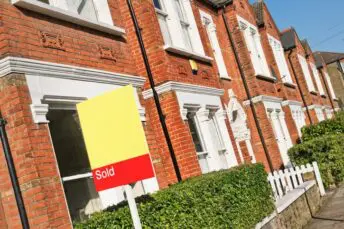House Price Watch July 2022
The rate of annual house price growth and market activity cools after a heated year. Buyer demand has fallen in the last three months along with mortgage activity. We expect this trend to continue as double digit inflation and rising interest rates add pressure to household budgets. House prices will remain underpinned by a shortage of homes for sale, though the rate of price growth is likely to continue to slow in the second half of the year.
What’s happening nationally
House prices are up on average +0.3% in the past month and +10.2% in the past year.
Indices based on:
Land Registry – registered property transactions in June.
Nationwide & Halifax – mortgage valuations in July.
Rightmove – asking prices posted on Rightmove in July.
*Rightmove is not included in the index average as the basis for its index is different (asking price vs agreed sale price)
| Index reports: | Monthly change | Annual change |
|---|---|---|
| Land registry | +1.0% | +7.8% |
| Nationwide | +0.1% | +11.0% |
| Halifax | -0.1% | +11.8% |
| Rightmove | +0.4% | +9.3% |
| Average change | +0.3% | +10.2% |
House prices in your area
Most areas of the UK have seen house prices up over the past month.
Annual house price growth is finally below double digits in most areas with the exception of Scotland (+11.6%)
In addition to Scotland, the biggest annual rises in house prices are in the East of England (+9.7%), Northern Ireland (+9.6%), the South East (8.9%) and the South West (8.0%). House price growth has been slowest in the North East (+3.6%) and Yorkshire & Humber (+4.2%).
Average house prices are highest in London (£538K) and lowest in the North East (£158K).
House price growth also varies by property type. Detached homes have seen the biggest rise (+9.5%) and flats/ maisonettes the smallest (+4.9%) according to Land Registry data.
| UK Region | Average price £ | Monthly change | Annual change |
|---|---|---|---|
| England | |||
| Nothern Ireland | |||
| Scotland | |||
| Wales | |||
| North West | |||
| Yorkshire and The Humber | |||
| North East | |||
| West Midlands | |||
| East Midlands | |||
| South West | |||
| East of England | |||
| South East | |||
| London |
| UK City | Average price | Annual change |
|---|---|---|
Market Monitor
Transactions in June fell below 100K for the first time in 2022. Transactions are well below June of last year which had record transactions coinciding with the end of the stamp duty holiday.
There were 95K transactions in June down 8% on May 2022 (104K), slightly lower than is typical for June in recent years (2017-2019).
Significant drop off in demand in the last three months. Stock of homes for sale improves slightly.
Time to sell slightly slower but still above the 12 month average.
How busy is the market?
- Not busy
- Normal
- Very busy
- Transactions lowest of 2022 and slightly lower than is usual in June in recent years.
- Total transactions in June 95K
- -8.0% from last month
- -54% lower than June last year (unusually high transactions with stamp duty holiday)
Homes for sale vs homebuyers
- Good availability of homes
- Normal
- Shortage of homes
- Buyer enquiries down (-25% RICS); fall in buyer demand in last 3 months but still above 2019 levels
- Seller enquiries down slightly (-5% RICS)
- Average stock per agent 47; on the rise (incl under offer/ Sold STC Rightmove)
Average speed of sale
- Fast
- Normal
- Slow
- 32 days to find a buyer (12 month average 36 days Rightmove)
What the experts say
Rightmove

“Though a softening in demand is moving the market from a boil to a simmer, it remains 26% up on 2019. There are signs of the seriously depleted stock situation improving, with the number of sellers up by 13% compared with this time last year, but the number of available homes for sale is still 40% down on where it was in 2019. With such an imbalance remaining between supply and demand, prices look underpinned, and we would therefore only expect typical smaller seasonal month-on-month falls, rather than more significant price falls in the second half of the year. This has led to us revising our annual price growth prediction for the end of the year from 5% growth to 7%, although this would still mark a slowing from the 9.3% seen this month.”
Nationwide

“The housing market has retained a surprising degree of momentum given the mounting pressures on household budgets from high inflation, which has already driven consumer confidence to all-time lows. While there are tentative signs of a slowdown in activity, with a dip in the number of mortgage approvals for house purchases in June, this has yet to feed through to price growth. We continue to expect the market to slow as pressure on household budgets intensifies in the coming quarters, with inflation set to reach double digits towards the end of the year. Moreover, the Bank of England is widely expected to raise interest rates further, which will also exert a cooling impact on the market if this feeds through to mortgage rates.”
Halifax

“Following a year of exceptionally strong growth, UK house prices fell last month for the first time since June 2021, albeit marginally. While we shouldn’t read too much into any single month, especially as the fall is only fractional, a slowdown in annual house price growth has been expected for some time. Leading indicators of the housing market have recently shown a softening of activity, while rising borrowing costs are adding to the squeeze on household budgets against a backdrop of exceptionally high house price-to-income ratios.”
Zoopla (Hometrack)

“House price growth and sales volumes are proving more resilient than many might have expected given the increases in the cost of living and initial increase in mortgage rates. The housing market is not immune to these growing economic headwinds but there are good reasons why market activity has been holding up. We expect demand for homes to weaken later in the year, but we are revising up our forecasts for house price growth and sales volumes for 2022.”
RICS

“The July 2022 RICS UK Residential Survey results are indicative of a continued easing in sales market activity, with metrics on demand and sales remaining in modestly negative territory over the month. Higher interest rates and a weakening macroeconomic landscape are widely cited by contributors to be causing this softening in momentum, although it’s important to note that the survey sample was largely gathered prior to the Bank of England’s latest 50 basis point rate hike. For the time being at least, underpinned by low levels of supply available for purchase, prices continue to rise across all parts of the UK.”




